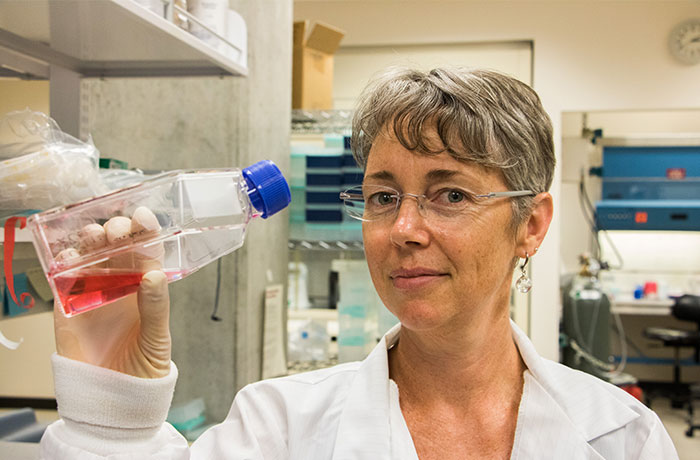
Aimee Edinger
Associate Professor
Developmental and Cell Biology
Successful tumor cells must develop strategies to grow even in the face of famine. Tumors do not have enough blood vessels to keep all the cancer cells well fed, and the blood vessels that are present are leaky and don’t function properly. Despite these supply-side limitations, tumor cells flourish and even manage to travel to new parts of the body where they form lethal metastases. How do they do it?
To reduce their dependence on the bloodstream, cancer cells scavenge material from their environment. Using a process called macropinocytosis, cancer cells form tidal wave-like membrane ruffles that scoop up extracellular material and drag it into the cell. The lysosome, or cellular stomach, breaks this material down into components that can be recycled to fuel growth.
In this article in Cancer Discovery, we show for the first time that prostate tumors use this trick to grow faster than their blood supply should allow. A new, ghoulish cancer cell behavior was also exposed: prostate cancers grow best when they feed on the corpses of their deceased neighbors. This finding has important ramifications for therapy. When patients are treated with radiation or drugs that trigger tumor cell death, the cancer cells that manage to survive can thrive by gorging on the mortal remains of the cells that succumbed to therapy.
Current therapies might be made more effective, and drug resistance suppressed, if drugs that block nutrient scavenging were co-administered with these treatments. The genetic changes that drive scavenging in prostate cancer are found across tumor classes. This means that inhibiting macropinocytosis is likely to be effective against tumor cells with many different origins, not just prostate cancers.
FDA-approved drugs are already available that limit macropinocytosis. However, cancer cells use multiple tricks to scavenge nutrients from their environment. The best approach would be to develop drugs that shut down all forms of nutrient scavenging simultaneously. This study provides insights that will guide the design of these new drugs. However, the Edinger lab has already teamed up with Stephen Hanessian’s medicinal chemistry group to produce a series of novel anti-cancer compounds that starve cancer cells to death by blocking scavenging as well as additional, parallel pathways for nutrient uptake. These agents are effective and non-toxic in mouse cancer models and could be tested in patients in 1-2 years.
